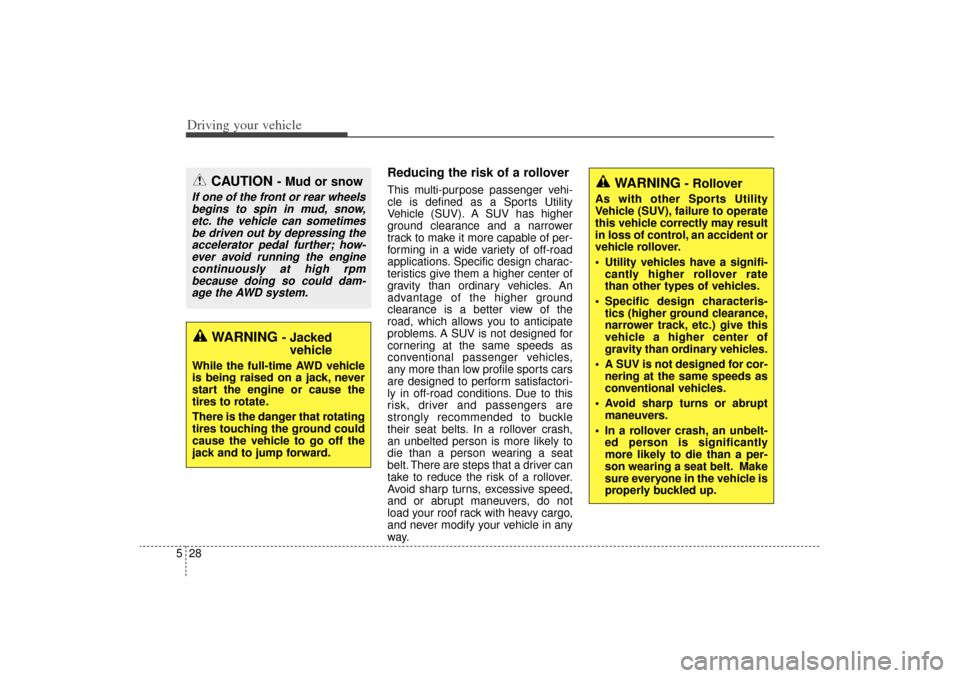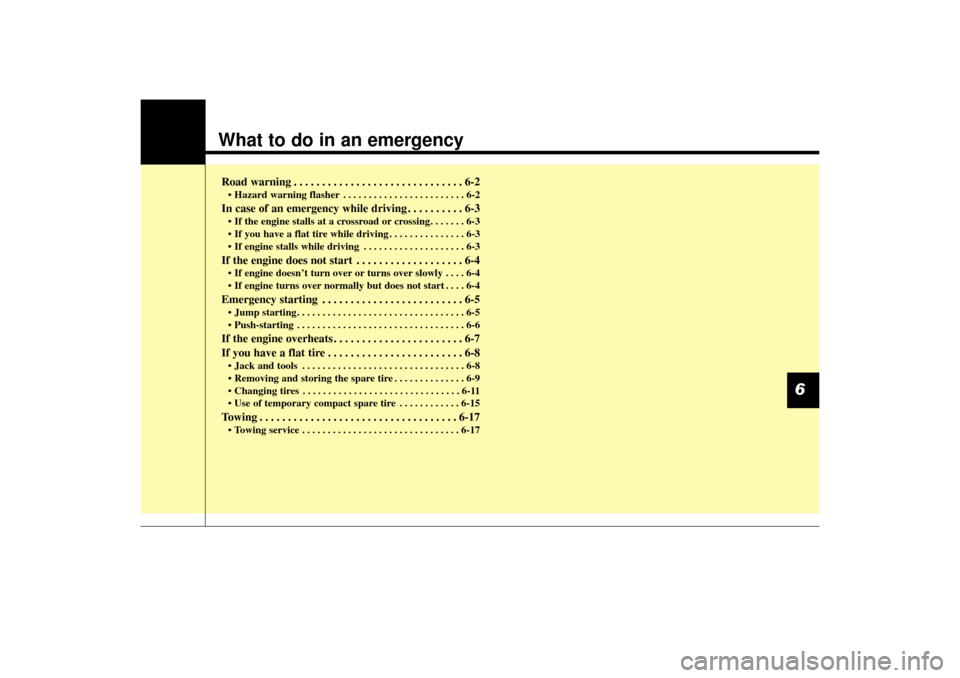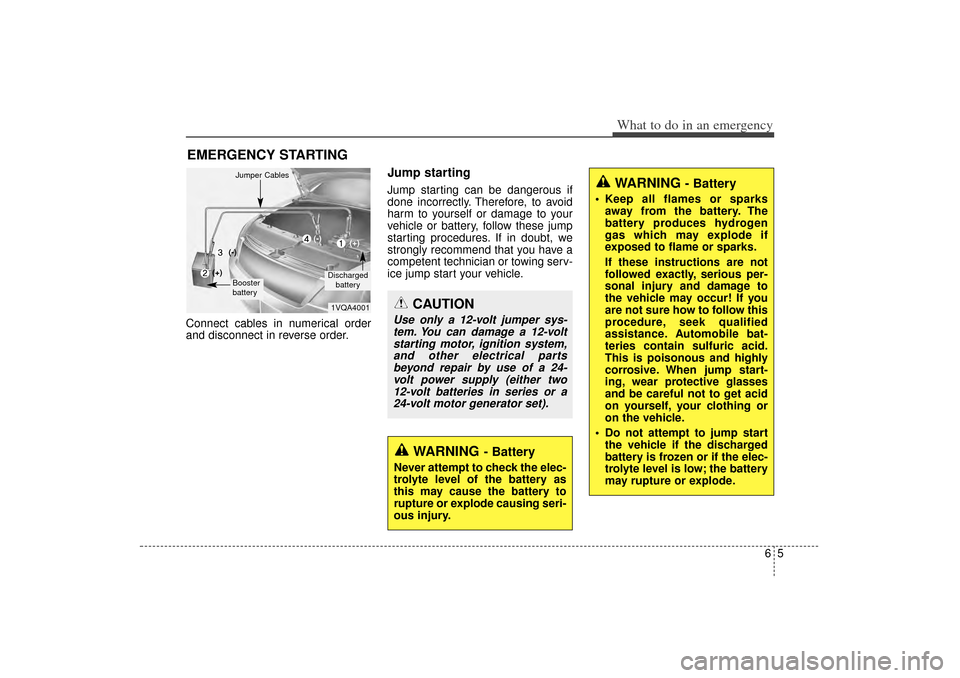2014 KIA Sorento jump start
[x] Cancel search: jump startPage 333 of 508

Driving your vehicle28
5
Reducing the risk of a rolloverThis multi-purpose passenger vehi-
cle is defined as a Sports Utility
Vehicle (SUV). A SUV has higher
ground clearance and a narrower
track to make it more capable of per-
forming in a wide variety of off-road
applications. Specific design charac-
teristics give them a higher center of
gravity than ordinary vehicles. An
advantage of the higher ground
clearance is a better view of the
road, which allows you to anticipate
problems. A SUV is not designed for
cornering at the same speeds as
conventional passenger vehicles,
any more than low profile sports cars
are designed to perform satisfactori-
ly in off-road conditions. Due to this
risk, driver and passengers are
strongly recommended to buckle
their seat belts. In a rollover crash,
an unbelted person is more likely to
die than a person wearing a seat
belt. There are steps that a driver can
take to reduce the risk of a rollover.
Avoid sharp turns, excessive speed,
and or abrupt maneuvers, do not
load your roof rack with heavy cargo,
and never modify your vehicle in any
way.
CAUTION
- Mud or snow
If one of the front or rear wheels
begins to spin in mud, snow,etc. the vehicle can sometimesbe driven out by depressing theaccelerator pedal further; how-ever avoid running the enginecontinuously at high rpmbecause doing so could dam-age the AWD system.
WARNING
- Jacked vehicle
While the full-time AWD vehicle
is being raised on a jack, never
start the engine or cause the
tires to rotate.
There is the danger that rotating
tires touching the ground could
cause the vehicle to go off the
jack and to jump forward.
WARNING
- Rollover
As with other Sports Utility
Vehicle (SUV), failure to operate
this vehicle correctly may result
in loss of control, an accident or
vehicle rollover.
Utility vehicles have a signifi-
cantly higher rollover rate
than other types of vehicles.
Specific design characteris- tics (higher ground clearance,
narrower track, etc.) give this
vehicle a higher center of
gravity than ordinary vehicles.
A SUV is not designed for cor- nering at the same speeds as
conventional vehicles.
Avoid sharp turns or abrupt maneuvers.
In a rollover crash, an unbelt- ed person is significantly
more likely to die than a per-
son wearing a seat belt. Make
sure everyone in the vehicle is
properly buckled up.
XM(FL) CAN(ENG) 5.QXP 1/23/2013 3:30 PM Page 28
Page 341 of 508

Driving your vehicle36
5
✽
✽
NOTICEWhen you jump start your vehicle
because of a drained battery, the
engine may not run as smoothly and
the ABS warning light may turn on
at the same time. This happens
because of low battery voltage. It
does not mean your ABS has mal-
functioned.
• Do not pump your brakes!
• Have the battery recharged before
driving the vehicle.
Electronic stability control
(ESC)The Electronic Stability control
(ESC) system is designed to stabi-
lize the vehicle during cornering
maneuvers. ESC checks where you
are steering and where the vehicle is
actually going. ESC applies the
brakes on individual wheels and
intervenes with the engine manage-
ment system to stabilize the vehicle.
CAUTION
When you drive on a road hav-
ing poor traction, such as anicy road, and have operatedyour brakes continuously, theABS will be active continuous-ly and the ABS warning lightmay illuminate. Pull your vehi-cle over to a safe place andstop the engine.
Restart the engine. If the ABS warning light goes off, thenyour ABS system is normal.Otherwise, you may have aproblem with the ABS.Contact an authorized Kiadealer as soon as possible.
OXMA053031
XM(FL) CAN(ENG) 5.QXP 1/23/2013 3:30 PM Page 36
Page 387 of 508

What to do in an emergencyRoad warning . . . . . . . . . . . . . . . . . . . . . . . . . . . . . . 6-2• Hazard warning flasher . . . . . . . . . . . . . . . . . . . . . . . . 6-2In case of an emergency while driving . . . . . . . . . . 6-3• If the engine stalls at a crossroad or crossing. . . . . . . 6-3
• If you have a flat tire while driving . . . . . . . . . . . . . . . 6-3
• If engine stalls while driving . . . . . . . . . . . . . . . . . . . . 6-3If the engine does not start . . . . . . . . . . . . . . . . . . . 6-4• If engine doesn’t turn over or turns over slowly . . . . 6-4
• If engine turns over normally but does not start . . . . 6-4Emergency starting . . . . . . . . . . . . . . . . . . . . . . . . . 6-5• Jump starting . . . . . . . . . . . . . . . . . . . . . . . . . . . . . . . . . 6-5
• Push-starting . . . . . . . . . . . . . . . . . . . . . . . . . . . . . . . . . 6-6If the engine overheats . . . . . . . . . . . . . . . . . . . . . . . 6-7
If you have a flat tire . . . . . . . . . . . . . . . . . . . . . . . . 6-8• Jack and tools . . . . . . . . . . . . . . . . . . . . . . . . . . . . . . . . 6-8
• Removing and storing the spare tire . . . . . . . . . . . . . . 6-9
• Changing tires . . . . . . . . . . . . . . . . . . . . . . . . . . . . . . . 6-11
• Use of temporary compact spare tire . . . . . . . . . . . . 6-15Towing . . . . . . . . . . . . . . . . . . . . . . . . . . . . . . . . . . . 6-\
17• Towing service . . . . . . . . . . . . . . . . . . . . . . . . . . . . . . . 6-17
6
XM(FL) CAN(ENG) 6.QXP 1/23/2013 3:33 PM Page 1
Page 390 of 508

What to do in an emergency46IF THE ENGINE WILL NOT STARTIf engine doesn't turn over or
turns over slowly1.If your vehicle has an automatictransaxle, be sure the shift lever is
in N (Neutral) or P (Park) and the
emergency brake is set.
2.Check the battery connections to be sure they are clean and tight.
3.Turn on the interior light. If the light dims or goes out when you operate
the starter, the battery is dis-
charged.
4.Check the starter connections to be sure they are securely tight-
ened.
5.Do not push or pull the vehicle to start it. See instructions for "Jump
starting".
If engine turns over normally
but does not start1.Check the fuel level.
2.With the ignition switch in theLOCK position, check all connec-
tors at the ignition coils and spark
plugs. Reconnect any that may be
disconnected or loose.
3.Check the fuel line in the engine compartment.
4.If the engine still does not start, call an authorized Kia dealer or seek
other qualified assistance.
WARNING
If the engine will not start, do
not push or pull the vehicle to
start it. This could result in a
collision or cause other dam-
age. In addition, push or pull
starting may cause the catalytic
converter to overload and cre-
ate a fire hazard.
XM(FL) CAN(ENG) 6.QXP 1/23/2013 3:33 PM Page 4
Page 391 of 508

65
What to do in an emergency
EMERGENCY STARTINGConnect cables in numerical order
and disconnect in reverse order.
Jump starting Jump starting can be dangerous if
done incorrectly. Therefore, to avoid
harm to yourself or damage to your
vehicle or battery, follow these jump
starting procedures. If in doubt, we
strongly recommend that you have a
competent technician or towing serv-
ice jump start your vehicle.
CAUTION
Use only a 12-volt jumper sys-tem. You can damage a 12-voltstarting motor, ignition system,and other electrical partsbeyond repair by use of a 24-volt power supply (either two12-volt batteries in series or a24-volt motor generator set).
WARNING
- Battery
• Keep all flames or sparks away from the battery. The
battery produces hydrogen
gas which may explode if
exposed to flame or sparks.
If these instructions are not
followed exactly, serious per-
sonal injury and damage to
the vehicle may occur! If you
are not sure how to follow this
procedure, seek qualified
assistance. Automobile bat-
teries contain sulfuric acid.
This is poisonous and highly
corrosive. When jump start-
ing, wear protective glasses
and be careful not to get acid
on yourself, your clothing or
on the vehicle.
Do not attempt to jump start the vehicle if the discharged
battery is frozen or if the elec-
trolyte level is low; the battery
may rupture or explode.
WARNING
- Battery
Never attempt to check the elec-
trolyte level of the battery as
this may cause the battery to
rupture or explode causing seri-
ous injury.
1VQA4001Discharged
battery
Jumper CablesBooster
battery(-)
(+)
(+)
(-)
XM(FL) CAN(ENG) 6.QXP 1/23/2013 3:33 PM Page 5
Page 392 of 508

What to do in an emergency66Jump starting procedure 1.Make sure the booster battery is12-volt and that its negative termi-
nal is grounded.
2.If the booster battery is in another vehicle, do not allow the vehicles to
come in contact.
3.Turn off all unnecessary electrical loads.
4.Connect the jumper cables in the exact sequence shown in the illus-
tration. First connect one end of a
jumper cable to the positive termi-
nal of the discharged battery (1),
then connect the other end to the
positive terminal of the booster
battery (2).
Proceed to connect one end of the
other jumper cable to the negative
terminal of the booster battery (3),
then the other end to a solid, sta-
tionary, metallic point (for example,
the engine lifting bracket) away
from the battery (4). Do not con-
nect it to or near any part that
moves when the engine is cranked. Do not allow the jumper cables to
contact anything except the correct
battery terminals or the correct
ground. Do not lean over the bat-
tery when making connections.
5.Start the engine of the vehicle with the booster battery and let it run at
2,000 rpm, then start the engine of
the vehicle with the discharged
battery.
If the cause of your battery discharg-ing is not apparent, you should haveyour vehicle checked by an author-ized Kia dealer.
Push-starting Vehicles equipped with automatic
transaxle lock system cannot be
push-started.
Follow the directions in this section
for jump-starting.
CAUTION
- Battery cables
Do not connect the jumper
cable from the negative terminalof the booster battery to thenegative terminal of the dis-charged battery. This can causethe discharged battery to over-heat and crack, releasing bat-tery acid.
WARNING
Never tow a vehicle to start it
because the sudden surge for-
ward when the engine starts
could cause a collision with the
tow vehicle.
XM(FL) CAN(ENG) 6.QXP 1/23/2013 3:33 PM Page 6
Page 502 of 508

Index4IDoor locks......................................................................4-\
21Central door lock switch ..........................................4-23
Child-protector rear door lock ..................................4-24
Drinks holders, see cup holders ..................................4-149
Driver position memory system ......................................3-8 Storing positions..........................................................3-9
Recalling positions ......................................................3-9
Easy access function ................................................3-10
Driver's and passenger's front air bag............................3-60
Driving at night..............................................................5-60
Driving in flooded areas ................................................5-61
Driving in the rain ........................................................5-60
Driving off-road ............................................................5-61
DRL see Daytime running light ..................................4-109
Economical operation ....................................................5-55
Electric chromic mirror (ECM) ....................................4-56
Electric power steering ..................................................4-49
Electronic stability control (ESC) ................................5-36
Emergency starting ..........................................................6-5 Jump starting ..............................................................6-5 Emission control system ................................................7-81
Crankcase emission control system ..........................7-81
Evaporative emission control System ......................7-81
Exhaust emission control system ..............................7-82
Engine ........................................................................\
......8-2
Engine compartment ........................................................2-6
Engine coolant ..............................................................7-33
Engine Coolant Temperature guage ..............................4-72
Engine number ..............................................................8-10
Engine oil ......................................................................7-\
31
Engine overheats..............................................................6-7
Engine start/stop button ..................................................5-8 Engine start/stop button position ................................5-8
Engine start/stop button position ....................................5-8
Engine will not start ........................................................6-4
Evaporative emission control System ..........................7-81
Exhaust emission control system ..................................7-82
Explanation of scheduled maintenance items ..............7-27
Exterior care ..................................................................7-74
Exterior overview (Front) ................................................2-2
Exterior overview (Rear) ................................................2-3E
XM(FL) CAN(ENG) Index.qxp 1/23/2013 3:41 PM Page 4
Page 504 of 508

Index6IIgnition switch position ..................................................5-5
Immobilizer system ........................................................4-8
Indicator light ................................................................4-91
Inside rearview mirror ..................................................4-55
Instrument cluster ..........................................................4-68Instrument panel illumination ..................................4-69
LCD Display Control ................................................4-70
Gauges ......................................................................4-\
71
Transaxle Shift Indicator ..........................................4-74
Instrument panel fuse ....................................................7-65
Instrument panel overview ..............................................2-5
Interior care....................................................................7-99\
Interior features............................................................4-149 Cup holder ..............................................................4-149
Sunvisor ..................................................................4-150
Bottle holder ............................................................4-150
Power outlet ............................................................4-151
Floor mat anchor(s) ................................................4-155
Luggage net (holder) ..............................................4-156
Side curtain..............................................................4-156
Interior lamp AUTO cut ..............................................4-117
Interior light ................................................................4-117 Interior lamp AUTO cut ..........................................4-117
Map lamp ................................................................4-118
Room lamp ..............................................................4-117
Luggage lamp ..........................................................4-119 Vanity mirror lamp ..................................................4-119
Interior overview ............................................................2-4
Jack and tools ..................................................................6-8
Jump starting....................................................................6-5
KEY ........................................................................\
........5-5 Ignition switch position ..............................................5-5
Keys ........................................................................\
........4-4 Immobilizer system ....................................................4-8
Label ........................................................................\
......3-77 Air bag warning label................................................3-77
Tire sidewall labeling ................................................7-56
Tire specification and pressure label ........................8-10
Refrigerant label ........................................................8-10
Lap/shoulder belt ..........................................................3-27
LCD display ..................................................................4-75 LCD modes ..............................................................4-75
Service Mode ............................................................4-76
User Settings Mode ..................................................4-78
A/V Mode..................................................................4-80
J
I
KL
XM(FL) CAN(ENG) Index.qxp 1/23/2013 3:41 PM Page 6